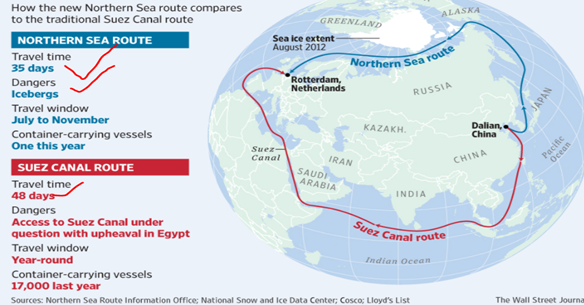

25th August 2023 (8 Topics)
Context
As per recent information, Murmansk, popularly called the capital of the Arctic region and the beginning point of the Northern Sea Route (NSR), is witnessing the rising trend of Indian involvement in cargo traffic. India has been showing greater interest regarding the NSR for a variety of reasons.
Background
- India's Arctic involvement traces back to the 1920 Svalbard Treaty.
- Through the Himadri station and multiple studies, India contributes to Arctic research, spanning atmosphere, biology, oceans, hydrology, and glaciers.
- India, becoming an Arctic Council observer in 2013, enhances its global role.
- Collaborative research and station establishment reflect India's commitment to understanding and addressing Arctic changes.
Why India is showing interest in Arctic Ocean?
- Economic Security: Arctic changes impact trade routes, affecting trade costs and hydrocarbon markets, indirectly influencing India's economic stability.
- Water Security: Melting Arctic ice contributes to rising sea levels, risking coastal areas and freshwater sources, impacting agriculture and industries crucial for India.
- Sustainability: Arctic shifts disrupt ecosystems, posing global ecological threats. India's Arctic Policy prioritizes UN Goals, highlighting its commitment to balanced development and environmental
What is Northern Sea Route (NSR)?
- The Northern Sea Route (NSR) is the shortest shipping route for freight transportation between Europe and countries of the Asia-Pacific region.
- It straddles four seas of the Arctic Ocean.
- Running to 5,600 km, the Route begins at the boundary between the Barents and the Kara seas (Kara Strait) and ends in the Bering Strait.
Why NSR is most preferred?
- A paper published on the website of the Arctic Institute in September 2011 states that in theory, distance savings along the NSR can be as high as 50% compared to the currently used shipping lanes via Suez or Panama.
- The 2021 blockage of the Suez Canal, which forms part of the widely-used maritime route involving Europe and Asia, has led to greater attention on the NSR.
Russia influence in NSR navigation:
- As the seas of the Arctic Ocean remain icebound during most of the year, the icebreaking assistance is organised to ensure safe navigation along the NSR.
- Russia is the only country in the world with a nuclear-powered icebreaker fleet.
|
In December 1959, the world’s first nuclear icebreaker, “Lenin,” was put into operation, unveiling the new chapter in the NSR development. It was decommissioned 30 years later. |
- Today, FSUE Atomflot, a subsidiary of Rosatom, acts as the fleet operator of nuclear-powered icebreakers. The fleet comprises seven nuclear-powered icebreakers, apart from one nuclear container ship.
Driving factors for India towards NSR:
- NSR Cargo Growth: Northern Sea Route (NSR) sees robust cargo traffic growth, benefitting India's energy imports from Russia, driven by its reliability and safety as a transport route.
- Strategic Transit Route: Given India's sea-trade dependence, NSR's transit role gains significance, aligning with India's geographical position and trade patterns, enhancing connectivity options.
- Development of Chennai-Vladivostok Corridor: Proposed corridor through NSR, part of India-Russia collaboration, shortens transport time significantly, facilitating efficient trade of coking coal, crude oil, LNG, and fertilizers between the nations.
Benefits:
- Cost effective: Fuel savings due to reduced distance;
- Lesser distance: The shorter distance reduces the cost of staff labor and chartering vessels;
- The Northern Sea Route does not charge payments for the passage (unlike, for example, the Suez Canal);
- Less cargo traffic: There are no queues (unlike, for example, the Suez Canal);
Suez Canal vs. Northern Sea Route:
Way forward for India:
- NSR Cargo Targets: Russian government's NSR development plan aims for substantial growth, targeting 80 million tonnes by 2024 and 150 million tonnes by 2030, amidst Western sanctions.
- Russian-Indian Collaboration: Russia engages with Indian business community, offering key components and seeking Indian company involvement in NSR projects, reflecting mutual interest in Arctic trade.
More Articles



